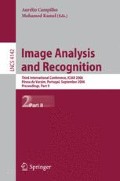Abstract
Finding the distance of an object in a scene from intensity images is an essential problem in many applications. In this work, we present a novel method for depth recovery from a single motion and defocus blurred image. Under the assumption of uniform linear motion between the camera and the scene during finite exposure time, both the pinhole model and the camera with a finite aperture are considered. The blur extent is estimated by intensity profile analysis and focus measurement of the deblurred images. The proposed method has been verified experimentally using edge images.
Access this chapter
Tax calculation will be finalised at checkout
Purchases are for personal use only
Preview
Unable to display preview. Download preview PDF.
References
Trucco, E., Verri, A.: Introductory Techniques for 3-D Computer Vision. Prentice-Hall, Englewood Cliffs (1998)
Subbarao, M., Surya, G.: Depth from defocus: A spatial domain approach. International Journal of Computer Vision 13, 271–294 (1994)
Rajagopalan, A.N., Chaudhuri, S.: Simultaneous depth recovery and image restoration from defocused images. In: CVPR, pp. 1348–1353. IEEE Computer Society, Los Alamitos (1999)
Favaro, P., Soatto, S.: A geometric approach to shape from defocus. IEEE Trans. Pattern Analysis and Machine Intelligence 27, 406–417 (2005)
Deschênes, F., Ziou, D., Fuchs, P.: An unified approach for a simultaneous and cooperative estimation of defocus blur and spatial shifts. Image and Vision Computing 22, 35–57 (2004)
Rajagopalan, A.N., Chaudhuri, S., Mudenagudi, U.: Depth estimation and image restoration using defocused stereo pairs. IEEE Trans. Pattern Anal. and Mach. Intell. 26, 1521–1525 (2004)
Banham, M., Katsaggelos, A.: Digital image restoration. IEEE Signal Processing Magazine 14, 24–41 (1997)
Kang, S., Min, J., Paik, J.: Segmentation-based spatially adaptive motion blur removal and its application to surveillance systems. In: International Conference on Image Processing, vol. I, pp. 245–248 (2001)
Brostow, G., Essa, I.: Image-based motion blur for stop motion animation. In: SIGGRAPH 2001 Conference Proceedings, ACM SIGGRAPH, pp. 561–566 (2001)
Ben-Ezra, M., Nayar, S.: Motion-based motion deblurring. IEEE Trans. Pattern Analysis and Machine Intelligence 26, 689–698 (2004)
Lin, H.Y.: Vehicle speed detection and identification from a single motion blurred image. In: WACV/MOTION, pp. 461–467. IEEE Computer Society, Los Alamitos (2005)
Slepian, D.: Restoration of photographs blurred by image motion. Bell System Tech. 46, 2353–2362 (1967)
Sondhi, M.: Image restoration: The removal of spatially invariant degradations. Proceedings of IEEE 60, 842–853 (1972)
Yitzhaky, Y., Mor, I., Lantzman, A., Kopeika, N.: Direct method for restoration of motion blurred images. Journal of the Optical Society of America 15, 1512–1519 (1998)
Fox, J.: Range from translational motion blurring. In: IEEE Computer Vision and Pattern Recognition, pp. 360–365 (1988)
Favaro, P., Burger, M., Soatto, S.: Scene and motion reconstruction from defocused and motion-blurred images via anisotropic diffusion. In: Pajdla, T., Matas, J(G.) (eds.) ECCV 2004. LNCS, vol. 3021, pp. 257–269. Springer, Heidelberg (2004)
Lai, S.H., Fu, C.W., Chang, S.: A generalized depth estimation algorithm with a single image. IEEE Trans. Pattern Analy. and Mach. Intell. 14, 405–411 (1992)
Asada, N., Fujiwara, H., Matsuyama, T.: Edge and depth from focus. International Journal of Computer Vision 26, 153–163 (1998)
Ens, J., Lawrence, P.: An investigation of methods for determining depth from focus. IEEE Trans. Pattern Analy. and Mach. Intell. 15, 97–108 (1993)
Hecht, E.: Optics. Addison-Wesley, Reading (2002)
Subbarao, M., Choi, T., Nikzad, A.: Focusing techniques. Optical Engineering 32, 2824–2836 (1993)
Horn, B.: Robot Vision. MIT Press, Cambridge (1986)
Nayar, S., Nakagawa, Y.: Shape from focus. IEEE Trans. Pattern Analysis and Machine Intelligence 16, 824–831 (1994)
Author information
Authors and Affiliations
Editor information
Editors and Affiliations
Rights and permissions
Copyright information
© 2006 Springer-Verlag Berlin Heidelberg
About this paper
Cite this paper
Lin, HY., Chang, CH. (2006). Depth Recovery from Motion and Defocus Blur. In: Campilho, A., Kamel, M. (eds) Image Analysis and Recognition. ICIAR 2006. Lecture Notes in Computer Science, vol 4142. Springer, Berlin, Heidelberg. https://doi.org/10.1007/11867661_12
Download citation
DOI: https://doi.org/10.1007/11867661_12
Publisher Name: Springer, Berlin, Heidelberg
Print ISBN: 978-3-540-44894-5
Online ISBN: 978-3-540-44896-9
eBook Packages: Computer ScienceComputer Science (R0)

